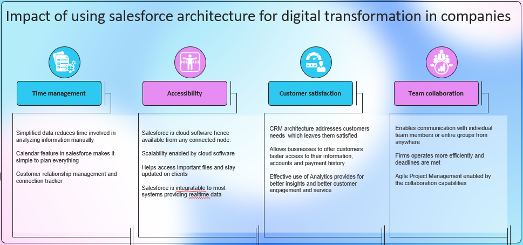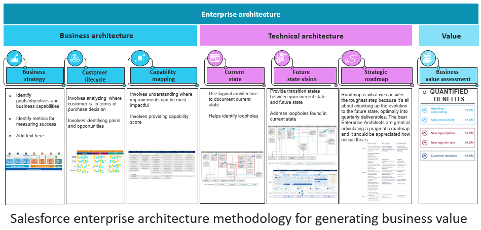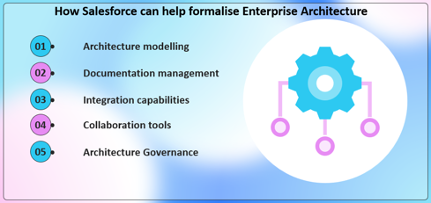
How can Salesforce enable Enterprise Architects to accelerate digital transformation and hence greater agility in their organisations?
Understanding what Salesforce can do to enable the agility required from a digital operating model.
Salesforce provides a powerful platform for agile organisations to manage their customer relationships and business processes efficiently. Here are some of the ways Salesforce can add value to agile organisations today:
· Agile project management: Salesforce offers a range of agile project management tools that can help organisations manage their projects effectively. These tools enable teams to collaborate in real-time, track progress, and adjust plans as needed. Tools such as Slack enable self-sufficient teams while still enabling the real time collaboration needed by DevOps teams and SCRUM teams.
· Customer relationship management: Salesforce is a leader in the CRM space and provides organisations with the tools they need to manage their customer relationships effectively. The platform offers a range of features such as customer tracking, lead generation, and customer analytics that can help organisations stay agile and responsive to customer needs. This level of agility is becoming increasingly important as organisations entrench their digital business models.
· Scalability: Salesforce is a cloud-based platform that can scale up or down as needed. This flexibility allows organisations to adapt quickly to changing market conditions and customer demands and hence stay very close to their customers.
· Integration: Salesforce can integrate with other software and applications, allowing organisations to streamline their business processes and reduce manual data entry. This integration also provides access to real-time data, enabling teams to make informed decisions quickly.
Overall, Salesforce can provide value to agile organisations by providing them with the tools they need to manage their customer relationships and business processes effectively, allowing them to be more responsive to market changes and customer needs (an ever more important requirement for organisations who are migrating to a digital business model as their primary means of doing business).
Some of the ways that Salesforce can benefit Enterprise Architecture

Salesforce can be extremely useful to an enterprise architect. Some of the ways Salesforce can benefit an enterprise architect include:
· Unified data management: Salesforce provides a centralised database for managing customer data, including sales leads, customer interactions, and marketing campaigns. This helps enterprise architects to ensure consistency and standardisation in data management across the organisation.
· Integration capabilities: Salesforce provides integration capabilities with other enterprise systems, including ERP, HRMS, and financial management systems. This helps enterprise architects to create a seamless, integrated IT environment that can support the organisation’s business processes.
· Business process automation: Salesforce offers a range of automation tools that can help to streamline business processes, such as sales and marketing workflows, customer service requests, and support tickets. Enterprise architects can use these tools to automate repetitive tasks and improve overall efficiency.
· Analytics and reporting: Salesforce provide robust reporting and analytics capabilities that can help enterprise architects to analyse customer data, track business performance, and make data-driven decisions. This can help organisations to improve customer engagement and increase revenue.
· Scalability: As a cloud-based platform, Salesforce can scale easily in small increments to meet the needs of growing organisations. This can help enterprise architects to design a scalable IT infrastructure that can support business growth and expansion.
In summary, Salesforce can be a valuable tool for enterprise architects, offering a unified data management platform, integration capabilities, automation tools, analytics and reporting, and scalability to support business growth.

Salesforce can also help to formalise enterprise architecture in agile organizations by providing a platform that supports the development, management, and documentation of enterprise architecture artifacts. Here are some examples:
· Architecture modelling: Salesforce provides modelling tools, such as custom objects and fields, which can be used to model enterprise architecture artifacts, such as business capabilities, data models, and technology architectures.
· Documentation management: Salesforce provides document management tools, such as Salesforce Files, which can be used to store and manage enterprise architecture documentation, such as architecture principles, standards, and guidelines.
· Integration capabilities: Salesforce provides integration capabilities that can be used to integrate enterprise architecture artifacts with other systems, such as project management tools, to provide a unified view of the organisation’s architecture.
· Collaboration tools: Salesforce provides collaboration tools, such as Slack and Chatter, which can be used to promote collaboration and communication among enterprise architects and other stakeholders.
· Architecture governance: Salesforce provides governance tools, such as access controls and change management processes, which can help enterprise architects to ensure that their architecture artifacts are properly managed and maintained.
By leveraging these capabilities, enterprise architects can use Salesforce to formalise their enterprise architecture practices, establish governance processes, and ensure that architecture artifacts are properly managed, documented, and communicated. This can help to promote consistency, alignment, and transparency across the organisation, while enabling agile development practices that support rapid innovation and continuous improvement.
Salesforce, if used correctly, can help to accelerate most organisation’s journey to a fully-fledged digital business model in ways that are cost effective and highly efficient. In WiRD’s experience, many organisations who have invested in Salesforce are only using a fraction of its capabilities. It can be a very powerful enabler of digital transformation enabled by formal enterprise architecture. What has your experience been in this regard? How effectively is your organisation using its investment in Salesforce? Please share your experiences with WiRD and each other by commenting or interacting on LinkedIn
